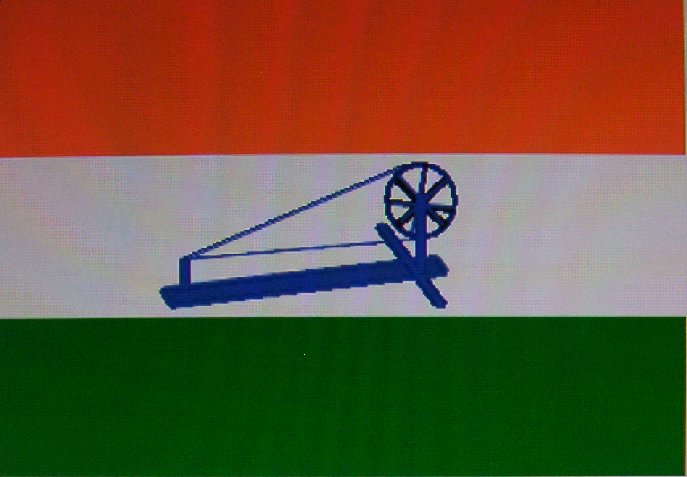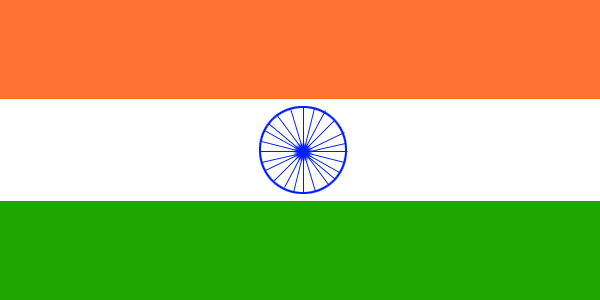| Home | About India | General Knowledge | Health | Hindu Religion | Music | News | About me |
India
|
The orange stripe atop had eight white lotuses embossed in a row.The words Vande Mataram were inscribed in the centre in the Devanagari script The green stripe had in white a sun on the left and a crescent and a star on the right.Some scholars have disputed on the crescent and star portion of it. On 1907-08-22, Bhikaiji Cama unfurled another tricolour flag in Stuttgart, Germany. This flag had green at the top, saffron in the centre and red at the bottom, the green standing for Islam and the saffron for both Hinduism and Buddhism. The flag had eight lotuses in a line on the green band representing the eight provinces of British India. The words Vande Mataram, in the Devanagari script, were inscribed on the central band. On the lowest band, towards the hoist of the flag was a crescent, and towards the fly a sun. The flag was jointly designed by Bhikaiji Cama, Veer Savarkar and Shyamji Krishna Varma. After the outbreak of World War I, this flag became known as the Berlin Committee Flag after it was adopted by the Indian Revolutionaries at the Berlin Committee. This flag was actively used in Mesopotamia during the First World War. The Ghadar Party flag was also used in the United States as a symbol for India for a short period of time.
Then came up the third flag as by then ,the Indian freedom struggle had taken a definite turn. During the Home Rule Movement,Dr Annie Besant,Lokmanya Tilak hoisted it.This flag had five red and four green horizontal stripes running alternatively,with the seven stars of the Saptarishi galaxy figuring there on. The Union Jack was embossed in the left hand top corner(the poll end). There was also a white crescent and star in the other corner. This configuration symbolised the aspirations of the time -the Union Jack,indicative of the goal of dominion status. This made the flag generally acceptable although the political message of a compromise was not popular. 1921
1931
1947
Dos and Don'ts
|
 In the next ten years,the Congress Party felt the need for an officially accepted flag.The flag that was in currency for ten years till then raised a controversy,especially at the time when communal disharmonyhad set in.A seven member committee of the AICC came up with a plain saffron flag with a deep red-brown mix Charkha at the left hand corner.It was no accepteable to the AICC,but a resolution was passed adopting a tricolour flag as the National Flag.This flag,the forbear of the present one ,was saffron,white and green.The colour configuration was interpreted without any communal overtones.The fresh interpretation offered was :"Saffron for courage and sacrifice,White for truth and peace,Green for faith and chivalry."The Charkha was retained in blue at the centre.The size was determined three breadths by two breadths.
In the next ten years,the Congress Party felt the need for an officially accepted flag.The flag that was in currency for ten years till then raised a controversy,especially at the time when communal disharmonyhad set in.A seven member committee of the AICC came up with a plain saffron flag with a deep red-brown mix Charkha at the left hand corner.It was no accepteable to the AICC,but a resolution was passed adopting a tricolour flag as the National Flag.This flag,the forbear of the present one ,was saffron,white and green.The colour configuration was interpreted without any communal overtones.The fresh interpretation offered was :"Saffron for courage and sacrifice,White for truth and peace,Green for faith and chivalry."The Charkha was retained in blue at the centre.The size was determined three breadths by two breadths. On July 22,1947,the Constituent Assembly adopted the above flag as free Indian National Flag.The advent of Independence caused only one change-the Charkha was replaced by the Chakra of Emperor Ashoka(The Congress Party retained the charkha version as the party flag.)
On July 22,1947,the Constituent Assembly adopted the above flag as free Indian National Flag.The advent of Independence caused only one change-the Charkha was replaced by the Chakra of Emperor Ashoka(The Congress Party retained the charkha version as the party flag.)